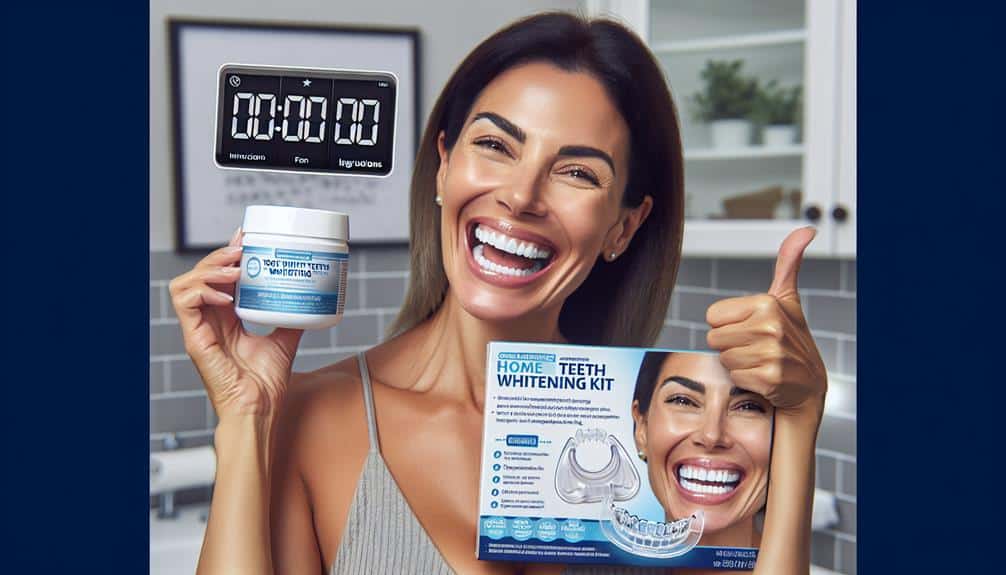Enhance your smile naturally at home by trying these seven effective ways to whiten your teeth. Start with oil pulling to improve oral hygiene and prevent plaque buildup. Make a gentle baking soda paste to scrub away surface stains cautiously. Brighten your smile with a hydrogen peroxide rinse to eliminate stains effectively. Activated charcoal powder binds to stains and balances pH levels in the mouth. Apple cider vinegar rinse is another great option for whitening teeth – dilute for safety and follow up with regular brushing. Give the strawberry rub a try for its gentle whitening properties.
Enhance your routine by incorporating coconut oil pulling, a traditional method that reduces plaque and freshens breath. Embrace these natural remedies for a brighter smile!
Key Points
- Oil pulling for improved oral hygiene and bacteria removal.
- Baking soda paste gently scrubs away stains and plaque.
- Hydrogen peroxide rinse for natural whitening effects.
- Activated charcoal powder binds to stains and balances pH.
- Apple cider vinegar rinse for effective whitening and oral health benefits.
Oil Pulling
To enhance the effectiveness of natural teeth whitening at home, consider incorporating oil pulling into your daily oral hygiene routine. Oil pulling is an ancient Ayurvedic practice that involves swishing oil around in your mouth to improve oral hygiene. This technique is believed to help remove bacteria, prevent plaque buildup, and promote overall dental health.
When practicing oil pulling for teeth whitening, it's recommended to use high-quality oils such as coconut oil or sesame oil. These oils have antimicrobial properties that can help combat harmful bacteria in the mouth. To start, take a tablespoon of your chosen oil and swish it around in your mouth for about 15-20 minutes, making sure not to swallow any of the oil. Afterward, spit out the oil and rinse your mouth with water.
Incorporating oil pulling into your daily routine can be a beneficial addition to your oral hygiene practices. It's a natural and gentle way to support teeth whitening while also promoting overall oral health.
Baking Soda Paste
Let's talk about the wonders of baking soda paste for teeth whitening. Discover the benefits it offers, learn the simple steps to make the paste, and find out how to apply it for effective results.
Baking soda paste is a natural and cost-effective way to brighten your smile at home.
Benefits of Baking Soda
Using baking soda as a paste for teeth whitening offers a cost-effective and natural alternative to commercial whitening products. Baking soda benefits teeth by gently removing surface stains and discoloration, resulting in a brighter smile. It's a mild abrasive that helps scrub away plaque buildup without causing damage to the enamel when used correctly.
However, it's essential to take precautions when using baking soda, as excessive scrubbing or using it too frequently can lead to enamel erosion over time. While baking soda is effective in whitening teeth, there are alternative methods available that may better suit individual preferences or tooth sensitivities.
Understanding the benefits and precautions of using baking soda can help you achieve a whiter smile naturally and safely.
Steps to Make Paste
Consider blending a small amount of baking soda with water to create a paste for your natural teeth whitening routine. Baking soda is a popular choice due to its mild abrasive properties that can help scrub away surface stains on teeth.
To make the paste, mix a small amount of baking soda with water in a small container until it forms a smooth consistency. You can adjust the ratio to achieve the desired thickness.
This simple paste is a cost-effective and natural alternative to commercial whitening products. By using natural ingredients like baking soda, you can create your DIY recipes for maintaining a brighter smile without harsh chemicals.
Application and Results
To fully maximize the benefits of the baking soda paste for natural teeth whitening, make sure you apply it gently in circular motions on your teeth for the best results. Here's how to apply and what to expect:
- Gentle Application: Apply the baking soda paste using a soft-bristled toothbrush, ensuring you cover all tooth surfaces evenly.
- Wait and Rinse: Leave the paste on for about two minutes to allow it to work its magic, then rinse thoroughly with water.
- Results: Over time, with consistent use, you may notice a gradual improvement in the whiteness of your teeth, especially when paired with good oral hygiene habits.
For a natural alternative to the lemon juice method or a comparison to commercial toothpaste, baking soda paste provides a cost-effective option amidst the DIY whitening kits and ongoing natural remedies debate.
Hydrogen Peroxide Rinse
For a natural way to brighten your smile at home, incorporating a hydrogen peroxide rinse into your oral care routine can help eliminate stains and promote a whiter appearance. Hydrogen peroxide is often used in mouthwash alternatives due to its whitening effects. It works by breaking down the compounds that cause discoloration on your teeth, helping to reveal a brighter smile.
To create a DIY teeth treatment using hydrogen peroxide, you can mix a small amount of it with an equal part of water. Swish this solution around in your mouth for about a minute, being careful not to swallow it. Then, rinse your mouth thoroughly with water. Ensuring to use food-grade hydrogen peroxide and to dilute it to a safe concentration is crucial to avoid irritation.
This natural solution can be used a few times a week to help maintain a whiter smile. Remember that while hydrogen peroxide can be effective in removing stains, using it in moderation is vital to prevent any adverse effects on your oral health.
Activated Charcoal Powder
Activated charcoal powder is a popular natural teeth whitening remedy known for its ability to remove surface stains effectively.
You can use activated charcoal powder by dipping a wet toothbrush into the powder and brushing your teeth for about 2 minutes.
Remember to rinse thoroughly after using charcoal powder to reveal a brighter smile.
Benefits of Charcoal
Discover the remarkable benefits that charcoal, specifically activated charcoal powder, can offer for natural teeth whitening at home. Activated charcoal is a powerful natural remedy that can enhance your oral hygiene routine. Here are three ways charcoal can benefit your teeth:
- Stain Removal: Activated charcoal powder effectively binds to and removes stains from the surface of your teeth, helping to brighten your smile.
- Natural Antibacterial Properties: Charcoal possesses antibacterial qualities, which can help in reducing harmful bacteria in your mouth, promoting overall oral health.
- Balances pH Levels: By balancing the pH levels in your mouth, charcoal can assist in preventing cavities and maintaining a healthy oral environment.
Incorporating activated charcoal powder into your dental care regimen can be a game-changer for achieving naturally whiter teeth.
How to Use
To effectively use activated charcoal powder for teeth whitening at home, begin by preparing a simple yet potent paste. Mix a small amount of activated charcoal powder with water to form a thick consistency. Gently brush the paste onto your teeth, ensuring all surfaces are covered.
Leave the charcoal paste on for about 2-3 minutes to allow it to bind to the stains on your teeth. Rinse thoroughly with water until all the charcoal residue is removed. Follow up by rinsing your mouth with a solution of lemon juice to help balance the pH levels in your mouth.
Apple Cider Vinegar Rinse
For a natural teeth whitening method that many people find effective, consider incorporating an apple cider vinegar rinse into your oral care routine. Apple cider vinegar is known for its vinegar benefits related to oral health and is often used in natural teeth whitening techniques.
Here's how you can make the most of this method:
- Dilute the vinegar: Mix one part apple cider vinegar with two parts water to create a solution that's gentle on your teeth and gums.
- Swish and rinse: Take a small amount of the diluted apple cider vinegar and swish it around in your mouth for about 30 seconds. Be careful not to swallow any of the solution.
- Follow up with regular brushing: After rinsing with apple cider vinegar, brush your teeth as usual to remove any remaining vinegar residue and help polish your teeth.
Incorporating an apple cider vinegar rinse into your oral care routine can be a natural and effective way to help whiten your teeth.
Strawberry Rub
Consider adding another natural teeth whitening technique to your routine with the strawberry rub method. Strawberries contain malic acid, a type of citrus exfoliation that can help remove surface stains on your teeth. The gentle abrasiveness of this fruit can aid in brightening your smile without causing damage to the enamel. However, owing to their acidic nature, it's crucial to use this method sparingly to avoid potential tooth sensitivity.
The enzyme properties present in strawberries can also contribute to improving your oral health. These enzymes have been linked to reducing plaque buildup and fighting bacteria in the mouth, which may help in maintaining a healthier smile overall.
To create a strawberry rub, mash a ripe strawberry into a pulp, apply it to your teeth, and leave it on for a few minutes before rinsing thoroughly. Remember to brush your teeth afterward to remove any residual fruit particles. Incorporating this natural remedy into your oral care routine occasionally can be an invigorating addition to your quest for whiter teeth.
Coconut Oil Pulling
Enhance your teeth whitening routine with the natural method of coconut oil pulling, a traditional practice that can help improve oral health and promote a brighter smile.
Coconut oil pulling involves swishing coconut oil around in your mouth to eliminate bacteria, plaque, and promote healthier gums.
Here are three key benefits of incorporating coconut oil pulling into your oral care routine:
- Reduced Plaque Build-Up: The lauric acid in coconut oil has antimicrobial properties that can help reduce plaque formation on your teeth, leading to a cleaner and brighter smile.
- Improved Gum Health: Coconut oil pulling can help combat harmful bacteria in the mouth, reducing the risk of gum disease and promoting overall gum health.
- Fresher Breath: By eliminating bacteria and toxins in the mouth, coconut oil pulling can help freshen breath naturally, giving you added confidence throughout the day.
Incorporating coconut oil pulling into your oral care regimen can be a beneficial addition to your quest for whiter teeth and better oral health through natural remedies.
Frequently Asked Questions
Can I Combine Multiple Natural Whitening Methods for Better Results?
When combining natural whitening methods, you may enhance results. However, be cautious of overuse risks. The benefits of a combination may vary in effectiveness duration. Consider potential sensitivity concerns before trying multiple methods simultaneously for teeth whitening.
Are There Any Potential Side Effects or Risks Associated With Using These Natural Whitening Methods?
When using natural whitening methods, it's important to be aware of potential risks. Some individuals may experience sensitivity concerns, so it's wise to test a small area first and consult with a dental professional for guidance.
How Long Does It Typically Take to See Noticeable Results From These At-Home Whitening Techniques?
You might find yourself pleasantly surprised by how quickly results start showing up when you combine these natural techniques. The speed of results and the combination benefits can make quite an impact on your smile!
Are These Natural Whitening Methods Safe for Individuals With Sensitive Teeth or Gums?
For those with sensitivity concerns, it's important to be cautious with natural remedies for teeth whitening. While some methods may be effective, they can potentially irritate sensitive teeth and gums. Prioritize gum health when exploring these options.
Can These Methods Be Used as a Long-Term Solution for Maintaining White Teeth, or Are They More Suited for Occasional Use?
For maintaining pearly whites long-term, these methods may need reinforcement. Regular use could keep your smile dazzling, but occasional reliance might yield better results. Consider balance for sustained brilliance.



